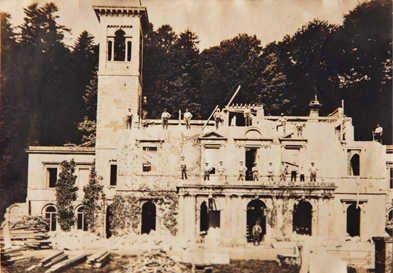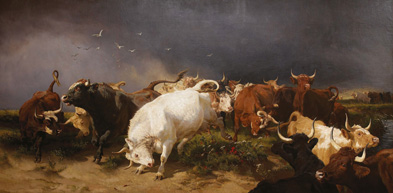Fonthill in the twentieth century
Part three: Fonthill’s First World War; the demolition of Fonthill House (the Pavilion)
For many country house owners, the period after the First World War meant downsizing, selling up or demolition. Landowners, who might have lost fathers and sons in the war, were now faced with increasing taxation. An estate which had paid 9 per cent of its gross rents in income tax, land tax and rates before 1914 might be paying 30 per cent in 1919. Worse still, the Budget of 1919 introduced death duties of 40 per cent on estates valued at £2 million and over. However, rents had remained steady for years, in some cases even falling during the war, and many landowners remained reluctant to raise them sufficiently to cover increased taxes. It was not surprising, therefore, that with the dramatic increases in the value of agricultural land during and immediately after the war, many landowners decided to sell. Those with large estates disposed of outlying parts; a few gave up the country life entirely.32 The sales of land began on a wide scale during the final months of the war. By 1919 there was an avalanche of sales; by 1921 a quarter of England had changed hands, some 6 to 8 million acres. Few estates were affected as much as Fonthill: three houses were demolished between 1921 and 1972, but each for different reasons.
During the war the Morrisons had continued to live in Alfred’s house by the lake. John Morrison later recalled the fire which broke out in April 1915: ‘I remember on Good Friday morning being woken up with my room full of smoke to be rushed downstairs, passing the hot cross buns floating on the kitchen floor’.33 The fire started in the servants’ quarters, in the hot water apparatus beneath the linen room.
The fire was discovered about half-past three in the morning, and the occupants of the house having been aroused Mr Morrison’s chauffeur was dispatched to Tisbury with a motor car to bring back the members of the Tisbury Fire Brigade … on the arrival of the eight members of the Tisbury Brigade under the Captain (Mr George Lush) and the Sub-Captain (Mr Arthur Hibberd) [the hydrants installed in the house] were at once requisitioned.34
Later in the night the Salisbury Fire Brigade arrived, pumping water from the lake. Flames burst through the roof of the servants’ quarters to the rear of the house but the main part of the house was left intact and habitable; no one was hurt and Alfred Morrison’s treasures were undamaged. After the war the builders resumed work at Little Ridge, completing the new wing by 1920. The final statement for the total cost of works submitted by Messrs Trollope & Colls. Ltd. on 31 October 1920 was for £83,327.1s.7d.
With Little Ridge completed, the old Fonthill House, the remaining Pavilion of Alderman Beckford’s ‘Splendens’, was surplus to requirements. Hugh decided to demolish it (Figure 7.6). Trollope & Colls. were again employed, supervising the demolition company of H. Salsey & Co.35 Mabel Morrison’s ‘Ranche’, her ‘retreat’ on Great Ridge, was also demolished. John Walton & Co. of Mere moved the china, tapestries and other pieces from Alfred Morrison’s collection up to Little Ridge before the sale of the building and the unwanted fixtures and fittings: the papers reported on ‘Fonthill House, which next week will be sold literally in pieces … as builder’s material …. The Catalogue contains just four hundred lots including … oak and mahogany doors, some of them inlaid … bookcases, carved mantel shelves … marble stairs, chandeliers.’36 At the same time Hugh asked his trustees if he could sell some of Alfred’s heirlooms and a list was drawn up. A massive steel and iron safe on a stand, by Zuloaga, was among the objects sold; also H. W. B. Davis’s very large painting A Panic (Figure 7.7), which found its way to the Beverley Art Gallery.

Fig. 7.6
The demolition of Fonthill House (the old Pavilion).
Photograph, Fonthill Estate Archives.

Fig. 7.7
H. W. B. Davis, A Panic, 1872.
Beverley Art Gallery, East Riding of Yorkshire Council.
The magnificent ivory and ebony cabinets designed for Fonthill House by Owen Jones were considered ‘totally unsaleable’, but a local Shaftesbury man Robert Borley snapped them up for £45 (see Chapter 17Figure 17.11). According to his descendants, Borley was born in about 1862, the illegitimate son of a maid employed by the Westminsters at Motcombe House. His father was reputed to be Richard de Aquila Grosvenor, future Lord Stalbridge.
According to his granddaughter Elspeth Huxley, Richard Grosvenor – known as ‘Dick the Devil’ – had spent an adventurous youth: ‘he had lived for a while with the Mormons in Salt Lake City, also with the Sioux Indians somewhere near the embryonic Chicago, and been present at the sacking of the Summer Palace in Peking in 1860. Returning home to settle down, he went, as tradition decreed, into politics, and as a Liberal represented Flintshire.’37 There is no evidence Grosvenor acknowledged Borley as his son, but the boy was given a good start in life and by the 1890s he was running the Grosvenor Hotel in Shaftesbury; before the war he also ran the King’s Arms, a blacksmiths and various stables and stores in the town.38
In 1918, the 2nd Lord Stalbridge sold his properties in Shaftesbury (most of the town), to a fictitious Mr White, actually Messrs. Gaskain and Benton, for £75,000. Borley and two others from the town then paid ‘Mr White’ £80,000 for the entire estate, ‘on behalf of the tenants’. Borley kept one of the largest houses, Barton Hill House, where he installed Owen Jones’s furniture from Fonthill.39 There was no stopping Borley. In 1920 he acquired the Ashcombe estate from the 13th Duke of Hamilton (another aristocrat intent on downsizing), installing a gamekeeper to look after the game. In 1930 he would let Ashcombe to Cecil Beaton, who recalled Borley was ‘a large and prosperous elderly man without much imagination but with a sound practical sense’.40
Meanwhile Hugh Morrison created a sports club on land immediately in front of the site of the old house: four tennis courts were laid out and later a cricket field and pavilion added. Part of the cricket field covered the site of the first Fonthill House. Hugh also decided to rename Little Ridge ‘Fonthill House’. Paintings by Charles Geoffroy-Dechaume of Little Ridge, now called Fonthill House, were shown at the Royal Academy Summer Exhibition in 1925 and reproduced in The Builder (see Chapter 18, Figure 18.9). In 1927 Hugh successfully petitioned for a grant of arms and badge, adopting the motto Prudentia Praetio Praestat or ‘prudence before any thought of a reward’. And in 1928 his son and heir married an heiress, the Hon. Margaret Smith, daughter of the 2nd Viscount Hambleden.41
Hugh did not enjoy his finished house for long; he died on 5 March 1931. There was a flurry of sales to cover death duties, but once again Alfred Morrison’s collection proved a rich source of cash.42 An extraordinarily ornate and heavy table by Zuloaga was acquired for the Royal Collection and is now in Buckingham Palace. Lady Mary was left their London house, but this was sold after her death in 1935; since 1946 it has housed the Caledonian Club.
Hugh’s only son John inherited the Fonthill Estate and Islay, as well as lucrative properties in the City of London, with no financial embarrassments. He was able to indulge his passion for horses, becoming Master of the South and West Wiltshire hunt in 1934.43 This was an unusual position to be in just before the outbreak of the Second World War (his uncle Archie Morrison had disposed of both the Basildon and Malham estates), and the contrast with his neighbours at Fonthill Abbey and Motcombe is striking.


